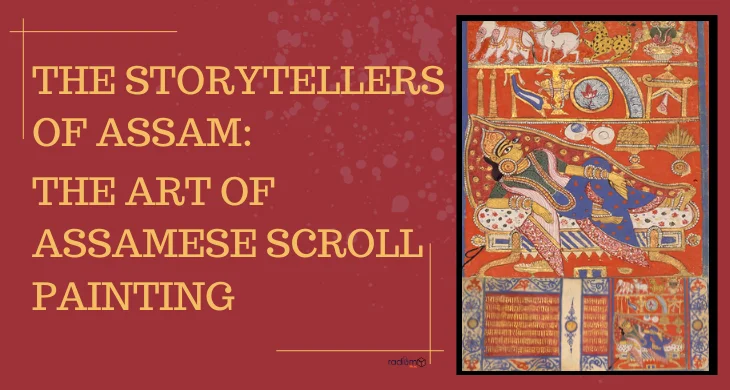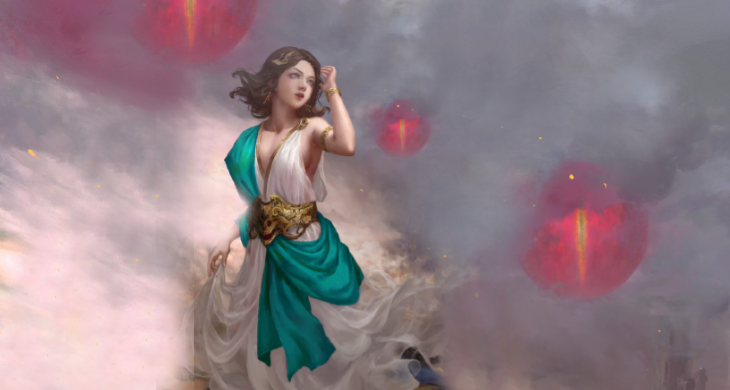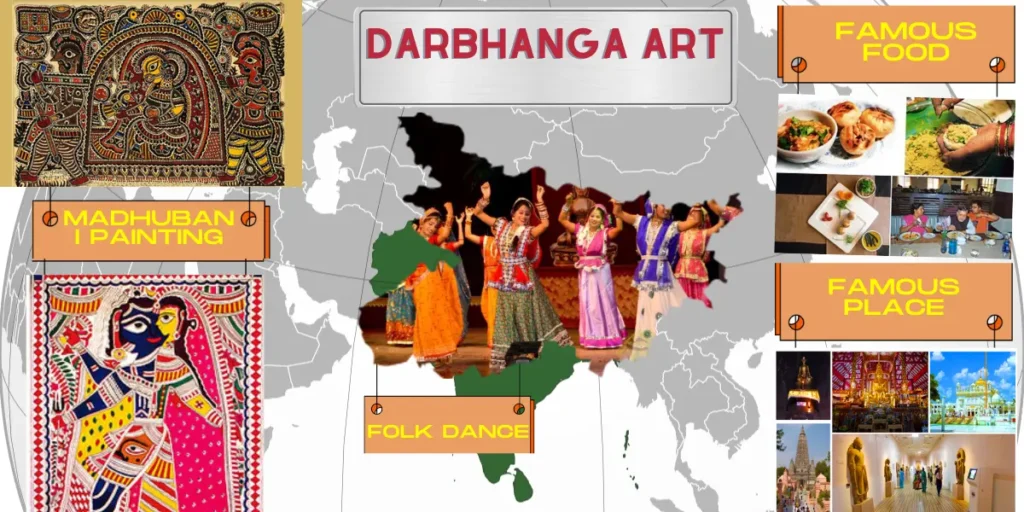Nestled in the northeastern region of India, Assam is not only renowned for its breathtaking landscapes and lush tea gardens but also for its rich cultural heritage. Among its many artistic treasures, Assamese Scroll Painting, a traditional and narrative art form, stands out as a testament to the state’s storytelling prowess.
Origins of Assamese Scroll Painting:
Assamese Scroll Painting, lovingly referred to as “Pothar” by the locals, is a captivating art form with deep roots that reach back through the annals of time. This traditional craft boasts an illustrious history that spans centuries, making it a true testament to the cultural heritage of Assam.
The essence of Assamese Scroll Painting lies in its role as a conduit for storytelling, particularly in the realms of religion and mythology. These paintings come to life on long, elegant scrolls crafted from silk or cotton fabric, akin to ancient manuscripts that beckon readers to journey into their narratives. Each scroll is a masterpiece, an intricately woven tale that unfolds like a storybook of old, revealing the myths, legends, and divine stories of gods, goddesses, and legendary heroes.
These scrolls are more than just artworks; they are living testaments to the storytelling prowess of Assam. As the scroll unfurls, it transports viewers into the heart of ancient tales, where epic battles, divine interventions, and moral lessons take center stage. The images meticulously painted on these scrolls are accompanied by inscriptions in Assamese script, adding a textual layer to the visual narrative.
The creation of Assamese Scroll Paintings is not a mere artistic pursuit; it is a labor of love, a reflection of the cultural and spiritual significance of the stories they depict. Each brushstroke, each pigment mixed from natural minerals, plants, and stones, is an ode to the rich traditions of Assam.
The Artistic Mastery of Assamese Scroll Painting:
The creation of Assamese Scroll Paintings stands as a testament to the meticulous artistry and unwavering dedication of skilled artisans. These craftsmen, affectionately known as “Pothar Gohain” or “Chitrakars,” embark on a labor-intensive journey to breathe life into these scrolls, infusing them with vibrant colors and intricate details.
- A Palette from Nature: At the heart of Assamese Scroll Painting lies a commitment to authenticity. Artisans carefully select and craft their pigments from natural sources, such as minerals, plants, and stones. These pigments yield a vivid and enduring spectrum of colors that not only capture the eye but also stand the test of time.
- Precision in Every Stroke: The creation of Assamese Scroll Paintings demands a steady hand and a keen eye for detail. Artisans use fine brushes to meticulously apply each stroke of color, ensuring that the images come to life with breathtaking clarity. The outlines are typically executed in black, providing a bold contrast that accentuates the storytelling elements.
- Panel by Panel, Story by Story: The scrolls are more than mere canvases; they are portals to captivating narratives. To structure these tales effectively, the artisans divide the scrolls into panels, each dedicated to a specific scene from the narrative. These panels flow seamlessly from one to the next, guiding viewers through the story’s progression.
- Borders and Ornate Flourishes: Intricate decorative borders adorn the panels, elevating the aesthetic appeal of Assamese Scroll Paintings. These borders often feature floral motifs and geometric patterns, adding an extra layer of visual richness to the artwork. They serve not only as decorative elements but also as symbolic expressions of the culture’s artistic heritage.
- Scripting the Tale: One distinctive feature of Assamese Scroll Painting is the inclusion of inscriptions in Assamese script. These inscriptions provide a textual backdrop to the visual narrative, enhancing the storytelling aspect of the art form. They guide viewers through the story, ensuring that the narrative’s depth is fully appreciated.
Themes and Narratives:
Assamese Scroll Paintings transport us to a world where myths and legends come alive on canvases that unfurl like sacred manuscripts. These vibrant scrolls are more than just art; they are windows to the rich religious and mythological heritage of Assam.
A Glimpse into Mythology: The heart and soul of Assamese Scroll Painting are its profound connections to religious and mythological narratives. These scrolls serve as visual chronicles, meticulously illustrating episodes from revered texts like the Mahabharata, Ramayana, and various Puranas. They provide viewers with an intimate look into the epic tales of gods, goddesses, and legendary heroes.
The Divine Presence: Among the recurring subjects, the stories of Lord Krishna, Lord Rama, and Goddess Durga stand out as timeless classics. These deities are brought to life with meticulous brushwork and vivid colors, capturing their divine essence and spiritual significance. The scrolls serve as conduits, allowing viewers to connect with the divine through visual storytelling.
Religious Significance: Assamese Scroll Paintings are not mere artistic creations; they play pivotal roles in religious ceremonies, festivals, and rituals. During these sacred occasions, the scrolls are unfurled, serving as invaluable visual aids that convey the narratives to the audience. They bridge the gap between the oral and the visual, ensuring that the religious teachings and stories are vividly imprinted in the minds and hearts of the faithful.
Cultural Significance:
The art of Assamese Scroll Painting, or “Pothar,” transcends the boundaries of mere artistic expression. It is an embodiment of Assam’s cultural soul—a vibrant tapestry interwoven with history, spirituality, and storytelling. Its significance resonates deeply within the hearts of the Assamese people, serving as a bridge between generations and a testament to the state’s rich cultural and religious heritage.
A Cultural Tapestry: Assamese Scroll Painting is not an isolated art form but a thread in the intricate tapestry of Assam’s cultural identity. It is a living legacy that has thrived for centuries, nurturing the roots of the community and connecting them to their past. The vibrant colors, intricate details, and captivating narratives serve as mirrors reflecting the essence of Assamese culture.
Preserving Tradition: Beyond its aesthetic allure, Assamese Scroll Painting is a guardian of tradition. It holds the stories, morals, and values that have been cherished for generations. These scrolls are not confined to museums or galleries; they are part of religious ceremonies, festivals, and rituals, ensuring that the cultural heritage they represent is alive and thriving.
Transmitting Wisdom: Assamese Scroll Paintings are not static artworks; they are dynamic storytellers. With each unfurling of the scroll, they transmit wisdom from the past to the present. They carry the teachings of the Mahabharata, the grace of Lord Krishna, and the valor of Lord Rama, reminding viewers of the timeless lessons embedded in these narratives.
Connecting Generations: The scrolls are not mere canvases; they are conduits through which the wisdom and spirituality of Assam flow from one generation to the next. Elders pass down the stories to their children and grandchildren, ensuring that the cultural torch remains lit. In this way, Assamese Scroll Painting is a living testament to the bonds that tie Assamese families together.
Challenges and Preservation Efforts:
The journey to preserve and protect Assamese Scroll Painting, a cultural gem that has adorned Assam’s heritage for centuries, is not without its challenges. While these scrolls have withstood the test of time, they now face contemporary hurdles that require dedicated efforts for their conservation.
The Diminishing Craftsmanship: One pressing challenge is the dwindling number of skilled artisans, the “Pothar Gohains” or “Chitrakars.” The art of Assamese Scroll Painting demands a unique skill set, and as older generations pass on, there is a risk of losing the mastery that has been handed down through the ages.
Scarce Traditional Pigments: Another concern is the availability of traditional pigments derived from minerals, plants, and stones. These natural sources are essential for achieving the vivid and enduring colors that define Assamese Scroll Painting. The scarcity of these materials poses a threat to the authenticity of the art form.
Preservation Initiatives: However, the love for Assamese Scroll Painting runs deep, and it fuels a spirit of preservation. Dedicated individuals and organizations have taken up the mantle to ensure that this art form continues to thrive. Their efforts include:
- Workshops and Training: Artisans and experts organize workshops to impart the skills required for Assamese Scroll Painting. These workshops serve as platforms for passing on knowledge to a new generation of artists.
- Exhibitions and Showcases: Art exhibitions and showcases provide a wider audience with an opportunity to appreciate and understand the artistry of Assamese Scroll Painting. These events raise awareness and generate interest in the craft.
- Documentation and Research: Scholars and researchers are engaged in documenting the history, techniques, and narratives associated with Assamese Scroll Painting. This documentation not only preserves the knowledge but also acts as a valuable resource for future generations.
- Supporting Artisans: Efforts are made to support and uplift the livelihoods of traditional artisans. This includes creating markets for their work, ensuring fair compensation, and promoting the craft as a sustainable means of income.
Ensuring a Flourishing Legacy: As Assamese Scroll Painting stands at the intersection of tradition and modernity, the challenges it faces are met with resilience and determination. The dedicated individuals and organizations that champion its cause are driven by a shared vision—to ensure that this art form continues to be a vibrant part of Assam’s cultural landscape. Through their unwavering efforts, Assamese Scroll Painting will not only endure but flourish, captivating new generations and preserving the stories and heritage of Assam for years to come.
Faqs:
Ques: What is Assamese Scroll Painting, and how does it differ from other art forms?
Ans: Assamese Scroll Painting, known as “Pothar,” is a traditional narrative art form from Assam. It distinguishes itself through its use of long scrolls to depict religious and mythological stories in a sequential manner, combining visual and textual elements for storytelling.
Ques: What are the typical themes and stories depicted in Assamese Scroll Paintings?
Ans:Assamese Scroll Paintings often revolve around themes from Hindu mythology and epics like the Mahabharata and Ramayana. They feature deities, gods, goddesses, and legendary heroes from these narratives.
Ques: What materials and techniques are used in creating Assamese Scroll Paintings?
Ans: Artisans use natural pigments derived from minerals, plants, and stones for coloring. The paintings are executed on silk or cotton fabric scrolls. Fine brushes and black outlines are used for intricate detailing.
Ques: Who are the artists responsible for creating Assamese Scroll Paintings, and what is their role in preserving this art form?
Ans:Skilled artisans, often referred to as “Pothar Gohain” or “Chitrakars,” are responsible for creating Assamese Scroll Paintings. They play a vital role preserving the art form through their craftsmanship and storytelling abilities.
Ques: How are Assamese Scroll Paintings used in Assamese culture and religious practices?
Ans: These scrolls are used as visual aids during religious ceremonies, festivals, and rituals to narrate stories from Hindu mythology. They serve as educational tools, conveying morals, values, and religious teachings.
Conclusion:
Assamese Scroll Painting, with its intricate blend of artistry and storytelling, emerges as a cultural gem of Assam. Through these scrolls, we are not merely observers of art; we become participants in the rich narratives of Hindu mythology, folklore, and tradition that have been handed down through generations.
The artisans, the Pothar Gohains, are the unsung storytellers who carry forward the mantle of this unique art form. They invest time, skill, and passion into each stroke of the brush, each pigment mix, and each delicate detail. Their dedication keeps the stories alive, bridging the past with the present.
Yet, Assamese Scroll Painting faces challenges. The modern world’s demands and dwindling resources pose threats to this cherished tradition. However, the spirit of preservation is strong. Communities, organizations, and individuals are working tirelessly to ensure that Assamese Scroll Painting endures




